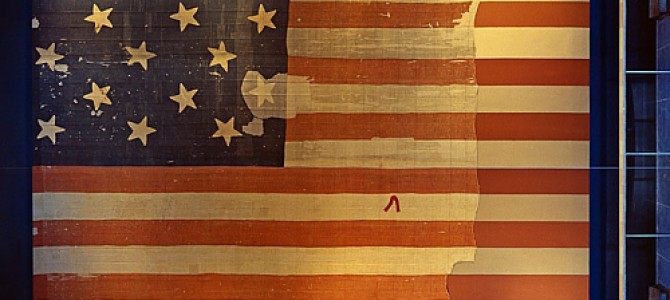
During the Battle of Baltimore on September 13 and 14, 1814, heavy thunderstorms over Fort McHenry prevented the flying of the flag we know today as the Star Spangled Banner. At 30 by 42 feet, it was so massive that, if waterlogged, it could weigh several hundred pounds and snap the flagpole. So instead, a smaller “storm flag” (17 by 25 feet) was flown during the furious battle.
After the British withdrew and the clash ended, American Maj. George Armistead had the storm flag lowered and the “great garrison flag” hoisted over the fort. The latter was the flag Francis Scott Key is presumed to have seen “by the dawn’s early light,” from a ship in Baltimore Harbor, and which inspired him to pen the words to our national anthem.
What happened to the actual flag that flew over the fort during the Battle of Baltimore, which endured the heavy bombardment? According to the Smithsonian’s Museum of American History, which houses the Star Spangled Banner, “the whereabouts of the storm flag are not known.”
It’s intriguing to consider the lost artifact of the storm flag. This would have been the flag that absorbed smoke and artillery hits during the actual battle. It would have been the flag battered and torn. It took the brunt of the battle, then was duly dispatched like a discharged soldier. It seems a bit like the fresh and dry garrison flag garnered all of the glory.
It’s as though the storm flag and great garrison flag represent two aspects of America: its struggles and its glory. The American flag as a symbol is weathering many political assaults and slights these days. Which makes Flag Day—June 14—a good time to reflect on its symbolism as a storm flag.
Old Glory and the Lone Individual
Americans who appreciate the flag’s meaning understand in their gut that the American system was built to protect a human being’s right to peacefully pursue his own happiness without harassment or interference from others. Especially from an oppressive government. This means that so many rights, including the right to raise one’s own family, worship in one’s own way, and to think aloud freely, are at stake. Individual rights like this may seem simple, but they are hard-won, and so rare in human history, that they have to be defended with vigilance. Otherwise they’re easily lost.
(Footnote on the slavery issue: The Constitution provided a not-perfect union of eighteenth-century states with a forge through which it could move towards a more perfect union. This meant the internal contradiction of slavery would inevitably have to be abolished. The document was built for that. It allowed for tempering and shaping a system that allowed ever-more people to enjoy liberty and pursue happiness. Unless they didn’t bother to understand this and decided to throw it all away.)
I doubt many millennials grasp that the Bill of Rights exists to protect them as lone individuals. Not as members of special groups, but as persons who are otherwise vulnerable to the whims of meddlesome bureaucrats or corrupt officials. The First Amendment means you don’t have to be a member of any special group to gain access to the right to speak or write or worship as you wish. It means you can choose on your own with whom to associate.
Yet this first principle of human freedom is being drowned out by identity politics, which does not recognize human beings as unique, whole individuals, but only as fragments of categorized groups based on ethnicity, “gender,” or whatever else.
So why would anyone in his right mind prefer the latter to the former? I think it’s because they don’t understand what’s at stake. You cannot appreciate what you don’t understand. Clearly, a growing number of Americans are unaware of what American freedom means, especially due to the massive decline of history and civics education over the past couple of generations. They don’t understand the significance of the flag because they don’t understand that the Constitution’s checks and balances work to prevent too much power in the hands of too few people.
A New Storm for Old Glory
In fact, there appears to be a growing trend in recent years to cultivate resentment for the American flag. For example, Charles Angeletti, a professor at Metropolitan State University in Colorado who claims America is a racist nation that doesn’t tolerate diversity of thought, requires his students to recite an “anti-Pledge of Allegiance” that goes like this:
I pledge allegiance to and wrap myself in the flag of the United States Against Anything Un-American, And to the Republicans for which it stands, two nations, under Jesus, rich against poor, with curtailed liberty and justice for all except blacks, homosexuals, women who want abortions, Communists, welfare queens, treehuggers, feminazis, illegal immigrants, children of illegal immigrants, and you, if you don’t watch your step.
Along those same lines, the student council at the University of California at Irvine voted in March to ban the American flag in the student union. They claimed that “freedom of speech, in a space that aims to be as inclusive as possible, can be interpreted as hate speech.” Although that vote was overturned, it indicates a trend of hostility towards the American flag, an antagonism which seems to have been cultivated—along with ignorance—on college campuses.
In addition, President Obama has been known to express a distaste for wearing a flag lapel pin, and has expressed ambivalence at best about the flag. So it goes. But there’s another flag he and the PC crowd seem to like just fine.
Is Rainbow Flag a Passing Fad, or Challenger to Old Glory?
You are probably well aware of the rainbow flag as a symbol used by the LGBT lobby since it was first introduced in the 1970s. It’s now a staple on college campuses and for lots of businesses eager to prove their allegiance to the LGBT agenda. Some American embassies have even flown it, including the ones in Tel Aviv and Madrid. Of course, it’s often flown in lieu of the American flag in front of many homes and businesses, large and small.
In fact, just the other day, while driving through downtown Washington DC, I saw rainbow flags prominently displayed at the Marriott Hotel as well as at the TD Bank on Fifteenth and P streets, NW. So it’s out there a lot. I expect you’ll see many more of them very soon—especially during the torchlight parading that’ll happen after Supreme Court Justice Anthony Kennedy, et al., rule against marriage as a male-female institution.
But how familiar are you with “New Glory?” That’s the name of a newer version of the rainbow flag that’s been popping up more these days. It’s sometimes referred to as the “gay American flag.” It’s a rainbow-spangled version of stars and stripes, in which the canton of the 50 stars on the blue field is placed in the same quadrant as Old Glory’s.
It will be interesting to see how this particular LGBT rainbow flag evolves, especially after the Supreme Court does its thing with marriage. Old Glory is sometimes interspersed and waved along with the rainbow flag at gay pride events, so one might cautiously joke in today’s confusing gender and political climates whether this means that the American flag is supposed to be “transitioning” into something “opposite” for which it stands?
The Rainbow Flag of ‘Peace’?
The symbolism of flags doesn’t necessarily translate from one flag to another, even when the colors, symbols, and even the placements thereof look the same. For example, the LGBT rainbow flag claims to stand primarily for the idea of diversity. But historically, the rainbow colors have also stood as a utopian peace flag, and was adopted by pacifists who rallied for world peace during and after World War I. It seemed to have gone dormant for a while, then was resurrected as a peace flag for anti-nuclear rallies, particularly in Europe, starting in 1961.
So it wouldn’t surprise me if there was some intended convergence somewhere in here. Pacifists—especially those of the Cold War era of the 1960s—have always tended to rally for a coercive peace in which the missions of the more collectivist-minded imperialist party (such as the Soviet Union) is the ultimate victor over the individualist-principled power (such as the USA), which always gets branded as the “imperialist” bad guy.
In like manner, the LGBT movement calls for a coerced tolerance, a coerced universal celebration of its vision. Both endorse censorship in the name of “peace” or “tolerance.” Both movements are utopian in nature and vision. Throughout history without exception, utopian movements have always depended upon coercion to see through their goals.
Since the Obama administration has set out to promote the LGBT agenda globally, and even embedded this goal in the new National Security Strategy, we might wonder if we’ll see the LGBT rainbow flag recycled at some point as a symbol of peace, albeit a coercive “peace.”
With this in mind, I think it’s interesting to compare utopian feminist Charlotte Perkins Gilman’s (d. 1935) pacifist poem “The Flag of Peace,” to the utopianism and intended globalism represented in the LGBT rainbow flag. The last four lines read as follows:
When all our flags shall blend in one,
And all our wars shall cease,
‘Neath the new flag, the true flag,
The rainbow flag of peace.
Sadly, there is no room for individual rights in such utopian visions. Neither is there room in them for the American flag, or any other symbol of the rights of human beings as individuals. Utopian visions are always collectivist in nature and coercive. They cannot abide any resistance, either active or passive.
Remember the Storm Flag
The pledge of allegiance doesn’t contain a reminder that the price of freedom is eternal vigilance. But it’s a hard truth we should never forget. It’s a struggle represented by the flag itself, especially symbolized by the lost Storm Flag that flew during the Battle of Baltimore. The First Amendment is being bombarded by deceits and the cultivation of ignorance, especially with laws that are using guise of “hate speech” as an excuse to police speech.
So Flag Day is a time to think about ways to rekindle the awe in others of living under a system that aims to protect the rights of human beings as purposeful individuals, rather than as obedient cogs in some all-powerful collective. More people need to discover that freedom is not merely an American ideal, but a universal and deeply human yearning.









